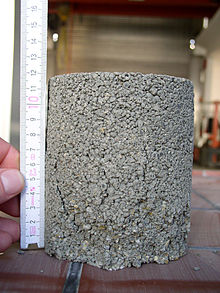Specific compression energy

The specific compression energy W (or volume-related compression work) is a common specification in the manufacture of Proctor bodies (see Proctor density ). It is given in MNm / m³.
Explanations
The production of a Proctor body takes place under standardized (DIN 18127 [2.93]) conditions, so the method of operation is specified and must be strictly adhered to. In the following, the specific compression energy in the manufacture of a Proctor body is derived and calculated as an example. With a simple Proctor density ρ Pr, there are 25 beats per layer filled, with 3 layers that is 75 beats. A test cylinder with a diameter d = 100 mm and a height h 1 = 120 mm is assumed . The mass of the falling weight of the compactor is G = 2.5 kg . The path (free fall) of the weight is h 2 = 30 cm .
calculation
The following specific energy results when manufacturing a Proctor body:
This can be converted at will. For example, if you want to calculate the volume-related compaction work during the incorporation of a paving stone into the bedding layer (see paving ), you can proceed as follows:
- Assumptions made
- Bedding height is 5 cm (when compacted)
- The area of the paving stone is 225 cm² (a / b = 15/15)
- 3 blows from a height of 22 cm with a 2.0 kg hammer (your own strength - when striking - is neglected here, as if the hammer were falling!).
conversion
As an example, the conversion from MNm / m³ to ft-lbf / ft³ should be carried out:
such as
- calculation
0.6 MNm / m³ therefore corresponds to approximately 12500 ft-lbf / ft 3 (ft-lbf = " foot-pound- force")
Web links
Individual evidence
- ↑ DIN EN 13286-2: 2013-02 Appendix A // Unbound and hydraulically bound mixtures - Part 2: Laboratory test method for determining the reference dry density and the water content - Proctor test

![{\ displaystyle W _ {\ rho _ {\ Pr}} \ approx (Schlaege) \ cdot \ left ({\ frac {G (kg) \ cdot h_ {2} (m) \ cdot 9.81 (m / s ^ {2})} {V _ {\ dim} (m ^ {3})}} \ right) \ cdot 10 ^ {- 6} \; [MNm / m ^ {3}]}](https://wikimedia.org/api/rest_v1/media/math/render/svg/26c8f6b84e150e83e8b57d0363c7a117c422a58b)




